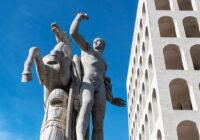Italy’s myths about fascism are not just widespread, but dangerously wrong.
Forlì is an ordinary kind of town, well off the tourist track, in the Emilia-Romagna region of northeast Italy. Its streets are quiet, and it boasts few of the architectural gems that characterize Italian cities. It is overshadowed by Ravenna to the south and the magnificent medieval Biblioteca Malatestiana in Cesena a few miles away. It does, however, have a claim to fame: It is the nearest large town to Predappio, the birthplace of Benito Mussolini.
With characteristic self-importance, Mussolini decided that Forlì should become the starting point of a pilgrimage to Predappio. As a result, the town has an oversized, pompous railway station, which leads directly onto a wide avenue along whose streets are modernist apartments built for the town’s Fascist elite and which leads to the Rationalist Quarter, a conglomeration of buildings built in the clean, modern style.
Among them is the former GIL (Gioventù Italiana del Littorio, Italian Youth of the Lictor, or the Fascist Party’s youth wing) building. Designed for mixed use, it housed a swimming pool, cultural center, fencing hall and gymnasium — healthy minds in healthy bodies. Like the buildings that surround it, it would not look out of place in Bauhaus Tel Aviv. The Fascist inscription that still adorns the tower, however, makes plain that context matters. The architect, Cesare Valle, was also responsible for the building next door, the Collegio Aeronautico della GIL, “Benito Mussolini,” or the aeronautical college of 1940. This building was designed to train pilots and to celebrate Italian aeronautical prowess, and is clearly inspired by the Futurists’ obsession with speed, violence and disdain for the weak.
To enter the building is to have quite a surprise: All around the internal courtyard is a series of mosaics celebrating the history of flying. This is a town and region famous for its mosaics from the Byzantine period onward; those in the San Vitale Cathedral in Ravenna are breathtaking. But along with the Wright Brothers and the other expected usual suspects, the mosaics provide an unashamedly Fascist interpretation of history. The uniformly grey and white mosaics are, it has to be said, beautiful, especially because of the impression made by the sheer quantity of them.
Amongst them are mosaics depicting famous flying units from the Great War, with the injunction to the students to “live dangerously,” quotations from Gabriele d’Annunzio, maps indicating the spread of Italy’s Fascist empire and images celebrating the tonnage of bombs dropped on Greece and Ethiopia. “I am bold, not prim” (Ardisco, non ordisco), one of them reads, or “The keyword is a simple categorical imperative for all: OVERCOME!” (La parola d’ordine è una sola categorica e impegnativa per tutti: VINCERE!) The message is unmistakable and, in its restrained aesthetic poise, powerful.
The biggest surprise is not merely the existence of these mosaics, however, which have survived the intervening decades in apparently good condition. Rather, it is the fact that the college continues to be used as a school. As the bell rings for the end of lessons, a crowd of teenagers, typical of any European school, throngs the courtyard moving on to the next class. They seem oblivious to the mosaics and to the visitors examining them.
Here is the problem. It is virtually impossible to imagine children in Germany attending a school adorned with swastikas or other accoutrements of the Nazi past; indeed, it would be illegal. Italy, as many commentators have observed in recent months, is a long way behind Germany when it comes to dealing with its Fascist past. A recent film imagining Mussolini’s return to the Italy of 2018, Sono tornato (I’m Back), is an obvious copy of Timur Vermes’ novel about Hitler, Er ist wieder da (Look Who’s Back).
Italy seems to be, in a curious echo of Fascist Italy’s relationship with the Third Reich, in a slow, responsive position, driven by events in Germany. In fact, the existence of Nazi Germany has assisted this process of not coming to terms with the past, since it was always easy to point to Nazi Germany and suggest that Italian Fascism, by comparison, was simply not as serious, not as dangerous. The notion of Mussolini as a kind of buffoon whose absurd self-representation left him ripe for satire has long meant that by comparison with Hitler he has been seen as more of a comedy figure than anything else.
Yet those who travel to Predappio to give the Fascist salute at his grave clearly do not regard Mussolini in that light. The history of Italian aggression against its neighbors and in Africa, the implementation of the 1938 Race Laws and the involvement of Italians in the Holocaust during the period of the Italian Social Republic (the Salò Republic) after the German occupation in 1943 speak against the notion of Italian Fascism as basically ridiculous and harmless.
Besides, as Italians well know, and as we have seen on the world stage, being ripe for satire is no guarantee against electoral success. In the run-up to the elections on March 4, warnings about xenophobic, nationalist violence grew stronger in Italy. Yet with each warning, and even in the aftermath of the murder of six Africans by neo-Nazi activist Luca Traini in Macerata in February, the success of Silvio Berlusconi’s coalition, which includes groups who in Italian terms would be identified as “post-fascist,” grew. The same is true of the only marginally less suspect Cinque Stelle (Five Star) movement, which seems to espouse a kind of socialist nationalism.
How can it be otherwise when fascism is the background, the mood music to people’s everyday lives, even in the most solidly anti-fascist region of Emilia-Romagna? Italy needs to tackle its fascist past with urgency and renewed vigor if the country is not to find out that its myths about fascism are not just widespread, but dangerously wrong.
*[Centre for Analysis of the Radical Right is a partner institution of Fair Observer.]
The views expressed in this article are the author’s own and do not necessarily reflect Fair Observer’s editorial policy.
Photo Credit: Tinxi / Shutterstock.com
Support Fair Observer
We rely on your support for our independence, diversity and quality.
For more than 10 years, Fair Observer has been free, fair and independent. No billionaire owns us, no advertisers control us. We are a reader-supported nonprofit. Unlike many other publications, we keep our content free for readers regardless of where they live or whether they can afford to pay. We have no paywalls and no ads.
In the post-truth era of fake news, echo chambers and filter bubbles, we publish a plurality of perspectives from around the world. Anyone can publish with us, but everyone goes through a rigorous editorial process. So, you get fact-checked, well-reasoned content instead of noise.
We publish 2,500+ voices from 90+ countries. We also conduct education and training programs
on subjects ranging from digital media and journalism to writing and critical thinking. This
doesn’t come cheap. Servers, editors, trainers and web developers cost
money.
Please consider supporting us on a regular basis as a recurring donor or a
sustaining member.
Will you support FO’s journalism?
We rely on your support for our independence, diversity and quality.







